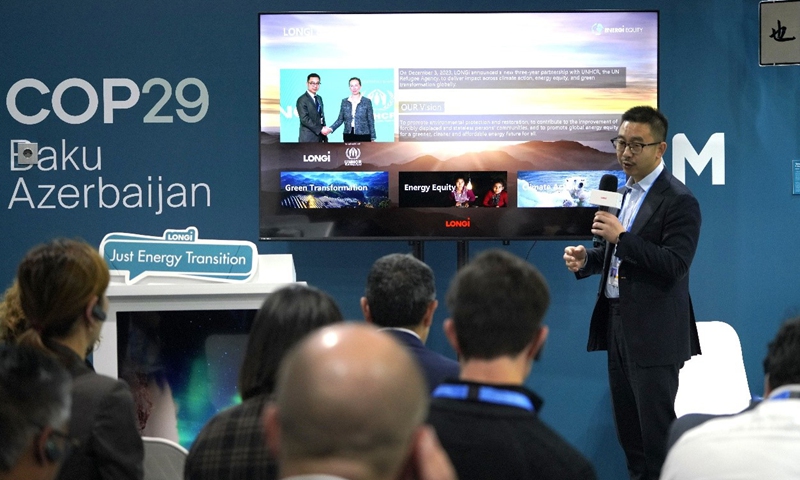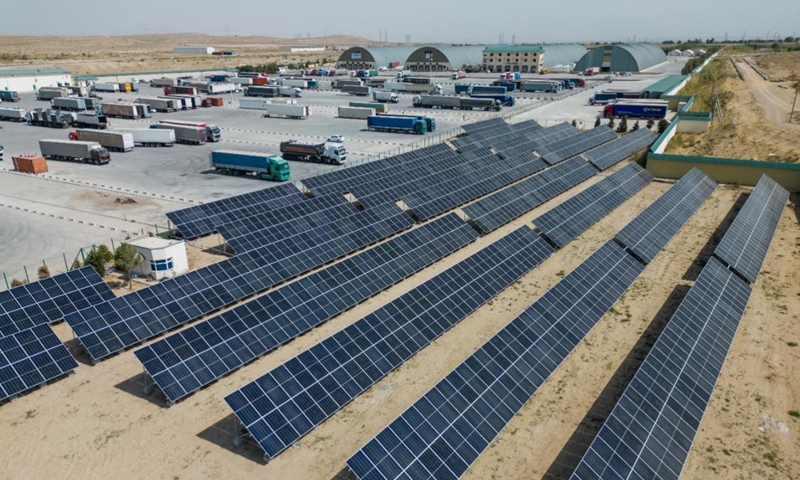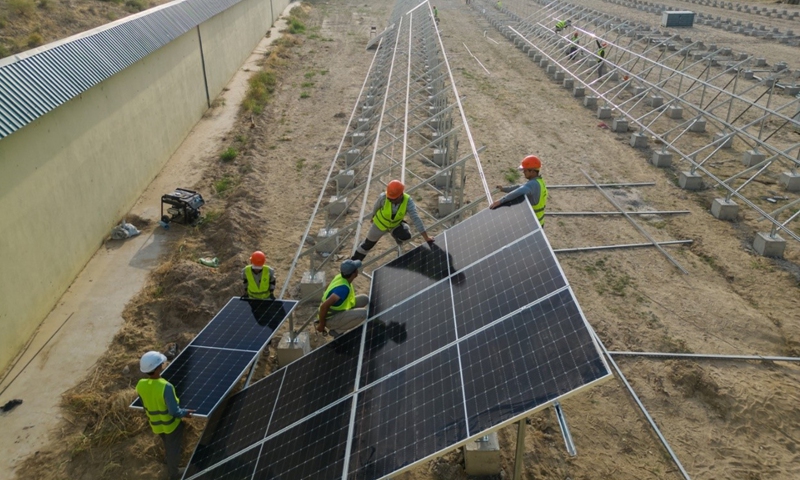SOURCE / PRESS RELEASE
LONGi advocates for accelerating energy transition through green innovation at COP29
On November 11, the 29th Conference of the Parties (COP29) to the United Nations Framework Convention on Climate Change kicked off in Baku, the capital of Azerbaijan. The conference focused on how to fairly and effectively allocate climate financing resources, ensuring that every penny can be used to its maximum effect, helping countries achieve low-carbon economic transformation and enhance climate resilience.
At this critical moment in the global fight against climate change, as an advocate, practitioner, and leader in sustainable development in the global clean energy field, LONGi participated to the COP29, advocating for the promotion of energy equity through green innovation. This marks LONGi's sixth consecutive participation in the United Nations Framework Convention on Climate Change.

Solarization of emergency stockpile in Uzbekistan completed
UNHCR, the UN Refugee Agency and LONGi, a leading global solar technology company, have completed a groundbreaking project to solarize the UNHCR Regional Humanitarian Logistics Hub located in the Termez Cargo Centre in Surkhandarya, Uzbekistan.

The project, part of a wider UNHCR-LONGi climate action partnership, marks a significant step toward ensuring a sustainable energy supply for logistics that support refugees and internally displaced people (IDPs) across the region and beyond.
The solarization has transformed the Hub into a critical operation powered by clean energy. With the installation of high-efficiency solar panels, a substantial amount of renewable energy will be generated each year, reducing the Hub's reliance on the grid and significantly lowering its carbon emissions.
“This transition to clean energy - a milestone in greening our supply chain globally - not only provides a renewable, reliable and cost-effective power source for the critical work that the Termez Supply Hub supports in the region, but also demonstrates UNHCR's strong commitment to environmental sustainability,” said Shoko Shimozawa, Director of UNHCR’s Division of Emergency, Security and Supply (DESS).
The 700kW solar photovoltaic power plant is expected to generate around 989,993kWh of electricity annually, reducing carbon emissions by approximately 495 metric tons per year. This will also result in significant annual electricity savings, which will benefit local energy infrastructure by reducing operating costs and allowing for reinvestment in further sustainable initiatives.
“By solarizing the Hub and partnering with UNHCR, LONGi is able to provide more efficient, reliable, safe and sustainable energy solutions for refugees around the world, accelerating the global energy transition and promoting energy equity,” said Dennis She, Vice President of LONGi. “Our vision is to promote a global energy transformation using BC (back-contact) solar technology, solving the electricity problem for people who are often without access to basic services, helping refugees to safeguard their rights and live in dignity.”
This partnership sets a precedent for future projects that aim to promote renewable energy adoption and improve the lives of vulnerable populations.
A milestone in UNHCR's efforts to achieve climate neutrality across its operations, the solarization of the Hub paves the way for further collaboration that draws on the skills and expertise of the private sector. By investing in renewable energy solutions, alongside strong partners, UNHCR is not only reducing its environmental impact but also building resilience and ensuring a sustainable future for refugees and IDPs.
The Hub, which has served as UNHCR’s regional emergency preparedness and response stockpile since 2021 primarily for the Afghanistan response, will be incorporated into UNHCR’s global stockpile network in 2025. This network, currently consisting of seven UNHCR stockpiles, enables the organization to respond to emergencies anywhere in the world by delivering core relief items (CRIs) - like blankets, mattresses, solar lamps and kitchen sets - to up to 1 million people who have been forced to flee their homes within 72 hours of an emergency being declared.

Turning emergency stockpile operations net carbon-neutral is a critical priority for the sustainability of UNHCR’s work. And the success if this pilot in Termez paves the way for similar projects around the globe.
Accelerating Global Energy Equity with Leading Photovoltaic Technology
Dennis She believes that energy equity lies in providing clean, affordable, and non-discriminatory energy services for all of humanity. However, there is currently a huge disparity in per capita energy consumption levels among countries worldwide, with the top 20 percent of economies consuming about 80 percent of the global energy. At the same time, approximately 11 percent of the global population still lives in darkness without electricity, and about one-third of the population cannot use clean energy for cooking, with energy poverty directly affecting local economic development and the improvement of people's quality of life. In addition, the uneven distribution of global energy resources and limited affordability also constrain the realization of energy equity on a global scale.
With the deepening implementation of global carbon neutrality goals, clean energy represented by photovoltaics will gradually become the backbone of the global energy transition. In particular, the technological and manufacturing attributes of photovoltaics continuously enhance their cost competitiveness, rapidly driving the process of energy transition.
Photo: LONGi and TechnoGroupService have collaborated on the construction of the Balkhash Solar Power Station in Kazakhstan
Solar energy is more widely and abundantly distributed globally than traditional fossil fuels, and it is more beneficial to developing countries. As a new type of clean energy, photovoltaic (PV) power generation has seen a rapid decrease in the cost per kilowatt-hour with the continuous development of photovoltaic technology. Photovoltaics have become the most economical source of electricity in the majority of countries and regions worldwide. Their sustainability, affordability, and characteristics of fairness and security provide an excellent solution to help achieve global energy equity.
As a global leading solar technology company, LONGi calls for global energy equity and has been driving global energy transition in all aspects, reducing the costs for people on the path to carbon neutrality. This will allow more people around the world, especially those in developing and underdeveloped countries and regions, to enjoy affordable clean energy and achieve energy equity. In 2022, Dennis She first advocated for global energy equity at COP27, calling for the allocation of limited resources to the popularization of renewable energy and urgent climate actions.
In the future, a new round of energy revolution centered on new energy will be accelerated, and the vision of a zero-carbon future will be realized sooner based on equal and economical distribution of clean electricity. At that time, light will be shed equally into every corner of the world, providing inclusive clean energy for all regions under all scenarios, truly achieving "SOLAR FOR ALL," and the world will have unlimited possibilities for sustainable development.
About LONGi
Founded in 2000, LONGi is committed to being a leading global solar technology company, focusing on customer-driven value creation for full scenario energy transformation.
Under its mission of 'making the best of solar energy to build a green world', LONGi has dedicated itself to technology innovation and established five business sectors, covering mono silicon wafers cells and modules, commercial and industrial distributed solar solutions, green energy solutions and hydrogen equipment. The company has honed its capabilities to provide green energy and has more recently embraced green hydrogen products and solutions to support global zero carbon development.
At this critical moment in the global fight against climate change, as an advocate, practitioner, and leader in sustainable development in the global clean energy field, LONGi participated to the COP29, advocating for the promotion of energy equity through green innovation. This marks LONGi's sixth consecutive participation in the United Nations Framework Convention on Climate Change.

Photo: Dennis She, Vice President of LONGi, addresses a keynote speech at Blue Zone COP29, Baku Olympic Stadium
On November 15, LONGi, in collaboration with Deeprock Group, hosted a special event titled "SOLAR FOR ALL—The Key to Tackling Climate Change: Green Innovation Accelerates Just Energy Transition" at the "Biosphere 3" Solutions Pavilion in the Blue Zone of COP29. The event showcased LONGi's latest scientific and technological achievements and project progress in the field of clean energy. Additionally, LONGi participated in a roundtable forum attended by representatives from the United Nations High Commissioner for Refugees (UNHCR), the China Electricity Council (CEC), the Global Energy Interconnection Development and Cooperation Organization (GEIDCO), the World Economic Forum (WEF), Energy Foundation (EF), and relevant NGOs. At the forum, LONGi shared its stories about "Energy Equity" and discussed how to help climate-vulnerable regions enhance their climate resilience.Solarization of emergency stockpile in Uzbekistan completed
UNHCR, the UN Refugee Agency and LONGi, a leading global solar technology company, have completed a groundbreaking project to solarize the UNHCR Regional Humanitarian Logistics Hub located in the Termez Cargo Centre in Surkhandarya, Uzbekistan.

Photo: A 700kW solar photovoltaic power plant has been installed at UNHCR's Emergency Logistics Hub in Termez.
The project, part of a wider UNHCR-LONGi climate action partnership, marks a significant step toward ensuring a sustainable energy supply for logistics that support refugees and internally displaced people (IDPs) across the region and beyond.
The solarization has transformed the Hub into a critical operation powered by clean energy. With the installation of high-efficiency solar panels, a substantial amount of renewable energy will be generated each year, reducing the Hub's reliance on the grid and significantly lowering its carbon emissions.
“This transition to clean energy - a milestone in greening our supply chain globally - not only provides a renewable, reliable and cost-effective power source for the critical work that the Termez Supply Hub supports in the region, but also demonstrates UNHCR's strong commitment to environmental sustainability,” said Shoko Shimozawa, Director of UNHCR’s Division of Emergency, Security and Supply (DESS).
The 700kW solar photovoltaic power plant is expected to generate around 989,993kWh of electricity annually, reducing carbon emissions by approximately 495 metric tons per year. This will also result in significant annual electricity savings, which will benefit local energy infrastructure by reducing operating costs and allowing for reinvestment in further sustainable initiatives.
“By solarizing the Hub and partnering with UNHCR, LONGi is able to provide more efficient, reliable, safe and sustainable energy solutions for refugees around the world, accelerating the global energy transition and promoting energy equity,” said Dennis She, Vice President of LONGi. “Our vision is to promote a global energy transformation using BC (back-contact) solar technology, solving the electricity problem for people who are often without access to basic services, helping refugees to safeguard their rights and live in dignity.”
This partnership sets a precedent for future projects that aim to promote renewable energy adoption and improve the lives of vulnerable populations.
A milestone in UNHCR's efforts to achieve climate neutrality across its operations, the solarization of the Hub paves the way for further collaboration that draws on the skills and expertise of the private sector. By investing in renewable energy solutions, alongside strong partners, UNHCR is not only reducing its environmental impact but also building resilience and ensuring a sustainable future for refugees and IDPs.
The Hub, which has served as UNHCR’s regional emergency preparedness and response stockpile since 2021 primarily for the Afghanistan response, will be incorporated into UNHCR’s global stockpile network in 2025. This network, currently consisting of seven UNHCR stockpiles, enables the organization to respond to emergencies anywhere in the world by delivering core relief items (CRIs) - like blankets, mattresses, solar lamps and kitchen sets - to up to 1 million people who have been forced to flee their homes within 72 hours of an emergency being declared.

Photo: Solar panels are installed at the Hub, which now runs on clean energy delivering humanitarian aid across Asia and beyond.
Turning emergency stockpile operations net carbon-neutral is a critical priority for the sustainability of UNHCR’s work. And the success if this pilot in Termez paves the way for similar projects around the globe.
Accelerating Global Energy Equity with Leading Photovoltaic Technology
Dennis She believes that energy equity lies in providing clean, affordable, and non-discriminatory energy services for all of humanity. However, there is currently a huge disparity in per capita energy consumption levels among countries worldwide, with the top 20 percent of economies consuming about 80 percent of the global energy. At the same time, approximately 11 percent of the global population still lives in darkness without electricity, and about one-third of the population cannot use clean energy for cooking, with energy poverty directly affecting local economic development and the improvement of people's quality of life. In addition, the uneven distribution of global energy resources and limited affordability also constrain the realization of energy equity on a global scale.
With the deepening implementation of global carbon neutrality goals, clean energy represented by photovoltaics will gradually become the backbone of the global energy transition. In particular, the technological and manufacturing attributes of photovoltaics continuously enhance their cost competitiveness, rapidly driving the process of energy transition.
Photo: LONGi and TechnoGroupService have collaborated on the construction of the Balkhash Solar Power Station in Kazakhstan
Solar energy is more widely and abundantly distributed globally than traditional fossil fuels, and it is more beneficial to developing countries. As a new type of clean energy, photovoltaic (PV) power generation has seen a rapid decrease in the cost per kilowatt-hour with the continuous development of photovoltaic technology. Photovoltaics have become the most economical source of electricity in the majority of countries and regions worldwide. Their sustainability, affordability, and characteristics of fairness and security provide an excellent solution to help achieve global energy equity.
As a global leading solar technology company, LONGi calls for global energy equity and has been driving global energy transition in all aspects, reducing the costs for people on the path to carbon neutrality. This will allow more people around the world, especially those in developing and underdeveloped countries and regions, to enjoy affordable clean energy and achieve energy equity. In 2022, Dennis She first advocated for global energy equity at COP27, calling for the allocation of limited resources to the popularization of renewable energy and urgent climate actions.
In the future, a new round of energy revolution centered on new energy will be accelerated, and the vision of a zero-carbon future will be realized sooner based on equal and economical distribution of clean electricity. At that time, light will be shed equally into every corner of the world, providing inclusive clean energy for all regions under all scenarios, truly achieving "SOLAR FOR ALL," and the world will have unlimited possibilities for sustainable development.
About LONGi
Founded in 2000, LONGi is committed to being a leading global solar technology company, focusing on customer-driven value creation for full scenario energy transformation.
Under its mission of 'making the best of solar energy to build a green world', LONGi has dedicated itself to technology innovation and established five business sectors, covering mono silicon wafers cells and modules, commercial and industrial distributed solar solutions, green energy solutions and hydrogen equipment. The company has honed its capabilities to provide green energy and has more recently embraced green hydrogen products and solutions to support global zero carbon development.
